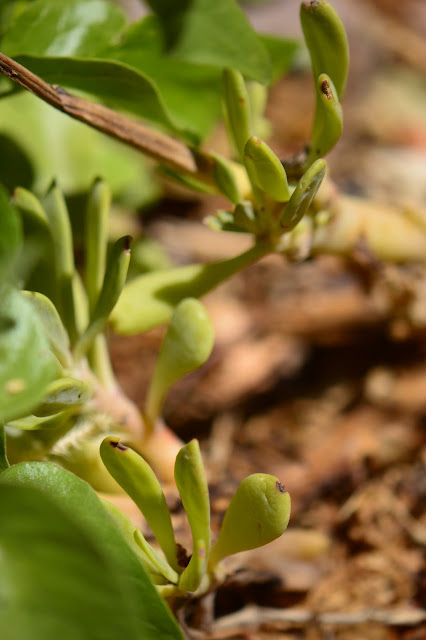 |
| Crown Princess Margareta |
 |
| Wollerton Old Hall |
But this post is not about the usual suspects.
Admittedly, the surprise is not very spectacular to look at, just some green leaves and sprawling stems.
And in fact, it has been around for several months, left in place in hopes it would give the Cistanthe just beside it some protection from dog feet. In the meantime, the remaining sprigs of Cistanthe have melted out beneath it...
 |
| I think I'm abandoning hope of growing Cistanthe spectabilis as a perennial here. |
Not the self-seeded Mirabilis I thought first...
 |
| For a while it was possible to confuse the foliage, and the Mirabilis grows close by. |
I found out very much by chance as there have been no flowers so far to assist with identification.
Two evenings ago, when I was planting one of my new irises in the North Border, I looked at the leaves of the nearby Chuparosa (Justicia californica). Then I reached out and touched them and felt that same silky texture that had been mystifying me in the unknown seedling.
 |
| Leaves on my original Justicia californica plant |
So the garden has given me a first self-seeded Chuparosa! I am amazed as the parent plant was only added to the border last spring, put on a dwindling floral show, and then, of course, ceased for the summer. Besides, I was not aware of J. californica having a reputation for seeding in the garden.
There are difficulties ahead. I will have to transplant it as it can't stay in its original spot close to the edge of the Central Bed, and so far I have a very poor record on transplanting desert natives. I hope this one will be more amenable to the process!
The common name means "hummingbird", and that is certainly one reason I planted this native of Sonoran Desert washes. My original plant had a hummingbird sipping from it as it waited in my cart at the GC. I wish I could post some pictures of hummingbirds and bloom, but that will have to wait till next year...!
Meantime, there are roses...
 |
| Wollerton Old Hall |


Congrats! I'm excited when a plant self-seeds in my garden (unless it's the mimosa tree, Albizia julibrissin, which is simply a pest). I hope your Justicia lives long and prospers.
ReplyDeleteIt does give me the feeling that the garden is taking on a life of its own - very rewarding :) The Justicia doesn't seem to have a reputation for being hard to control, so hopefully it won't be a garden hog (too bad about the mimosa; it's such a pretty tree otherwise!).
DeleteHummingbirds!
ReplyDeleteThe two bietou bushes I have planted on the verge were garden volunteers, and are now reaching happily for my shoulders.
That sounds great, Diana :) It's a treat when it's good garden plants instead of weeds!
Deletehttp://eefalsebay.blogspot.co.za/2015/12/somerset-west-open-gardens-hospice.html
ReplyDeletejust realised, your Justicia was the new to me plant I admired in an Open Garden. It does give a spectacular colourful display!
I loved your tour of those gardens - how refreshing! I'm afraid my Justicia isn't quite as spectacular as that, which looks to me like the more tropical J. brandegeeana. My desert native J. californica has bright but very narrow flowers more sparsely set. It is eminently suited to the climate though, and is clearly making itself at home... It has actually put out a few flowers since I wrote the above; I shall have to try to photograph and post them! :)
Delete